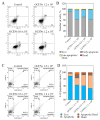Exosome-like Nanoparticles, High in Trans-δ-Viniferin Derivatives, Produced from Grape Cell Cultures: Preparation, Characterization, and Anticancer Properties
- PMID: 39335655
- PMCID: PMC11428831
- DOI: 10.3390/biomedicines12092142
Exosome-like Nanoparticles, High in Trans-δ-Viniferin Derivatives, Produced from Grape Cell Cultures: Preparation, Characterization, and Anticancer Properties
Abstract
Background: Recent interest in plant-derived exosome-like nanoparticles (ENs) has surged due to their therapeutic potential, which includes antioxidant, anti-inflammatory, and anticancer activities. These properties are attributed to their cargo of bioactive metabolites and other endogenous molecules. However, the properties of ENs isolated from plant cell cultures remain less explored. Methods: In this investigation, grape callus-derived ENs (GCENs) were isolated using differential ultracentrifugation techniques. Structural analysis through electron microscopy, nanoparticle tracking analysis, and western blotting confirmed that GCENs qualify as exosome-like nanovesicles. Results: These GCENs contained significant amounts of microRNAs and proteins characteristic of plant-derived ENs, as well as trans-δ-viniferin, a notable stilbenoid known for its health-promoting properties. Functional assays revealed that the GCENs reduced the viability of the triple-negative breast cancer cell line MDA-MB-231 in a dose-dependent manner. Moreover, the GCENs exhibited negligible effects on the viability of normal human embryonic kidney (HEK) 293 cells, indicating selective cytotoxicity. Notably, treatment with these GCENs led to cell cycle arrest in the G1 phase and triggered apoptosis in the MDA-MB-231 cell line. Conclusions: Overall, this study underscores the potential of grape callus-derived nanovectors as natural carriers of stilbenoids and proposes their application as a novel and effective approach in the management of cancer.
Keywords: Vitis vinifera; callus culture; cancer; extracellular vesicles; salicylic acid.
Conflict of interest statement
The authors declare no conflict of interest.
Figures







Similar articles
-
Highly Efficient Bioconversion of trans-Resveratrol to δ-Viniferin Using Conditioned Medium of Grapevine Callus Suspension Cultures.Int J Mol Sci. 2022 Apr 15;23(8):4403. doi: 10.3390/ijms23084403. Int J Mol Sci. 2022. PMID: 35457219 Free PMC article.
-
Oligostilbenoids in Vitis vinifera L. Pinot Noir grape cane extract: Isolation, characterization, in vitro antioxidant capacity and anti-proliferative effect on cancer cells.Food Chem. 2018 Nov 1;265:101-110. doi: 10.1016/j.foodchem.2018.05.050. Epub 2018 May 10. Food Chem. 2018. PMID: 29884360
-
Extracellular vesicles of cannabis with high CBD content induce anticancer signaling in human hepatocellular carcinoma.Biomed Pharmacother. 2022 Aug;152:113209. doi: 10.1016/j.biopha.2022.113209. Epub 2022 Jun 3. Biomed Pharmacother. 2022. PMID: 35667235
-
Vitis vinifera (Vine Grape) as a Valuable Cosmetic Raw Material.Pharmaceutics. 2023 Apr 29;15(5):1372. doi: 10.3390/pharmaceutics15051372. Pharmaceutics. 2023. PMID: 37242614 Free PMC article. Review.
-
Plant Exosome-like Nanovesicles: Emerging Therapeutics and Drug Delivery Nanoplatforms.Mol Ther. 2021 Jan 6;29(1):13-31. doi: 10.1016/j.ymthe.2020.11.030. Epub 2020 Dec 3. Mol Ther. 2021. PMID: 33278566 Free PMC article. Review.
Cited by
-
Potential Transformation of Food Resveratrol: Mechanisms and Biological Impact.Molecules. 2025 Jan 24;30(3):536. doi: 10.3390/molecules30030536. Molecules. 2025. PMID: 39942639 Free PMC article. Review.
-
Multifaceted Therapeutic Potential of Plant-Derived Exosomes: Immunomodulation, Anticancer, Anti-Aging, Anti-Melanogenesis, Detoxification, and Drug Delivery.Biomolecules. 2025 Mar 10;15(3):394. doi: 10.3390/biom15030394. Biomolecules. 2025. PMID: 40149930 Free PMC article. Review.
-
The potential of plant-derived vesicles in treating periodontitis and associated systemic diseases: current advances and future directions.J Nanobiotechnology. 2025 Aug 18;23(1):568. doi: 10.1186/s12951-025-03651-0. J Nanobiotechnology. 2025. PMID: 40826362 Free PMC article. Review.
References
Grants and funding
LinkOut - more resources
Full Text Sources
Miscellaneous

